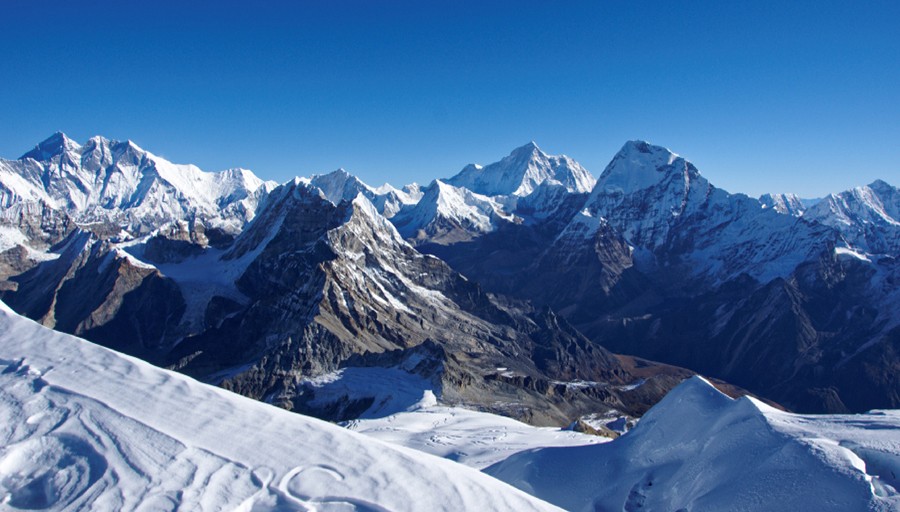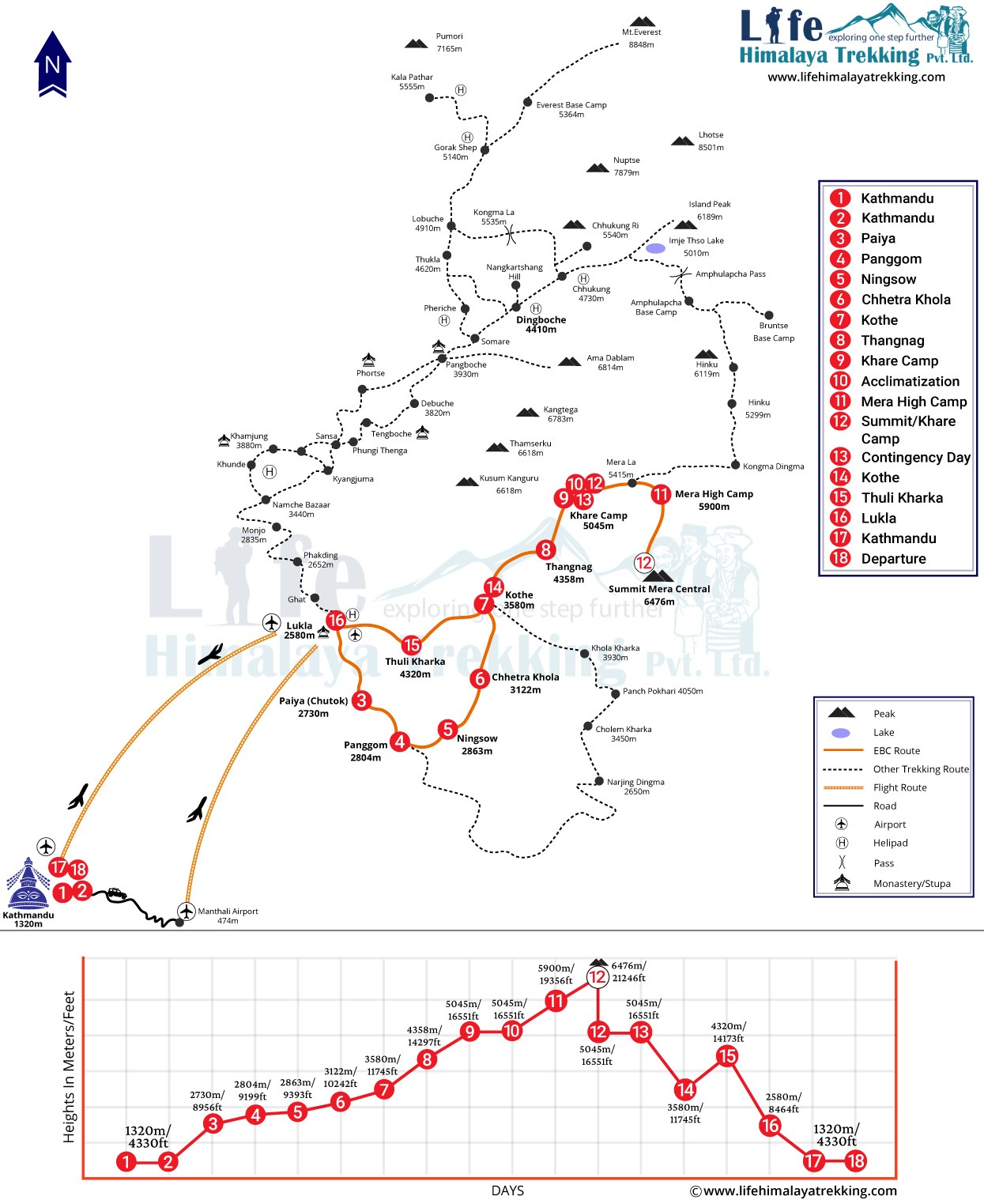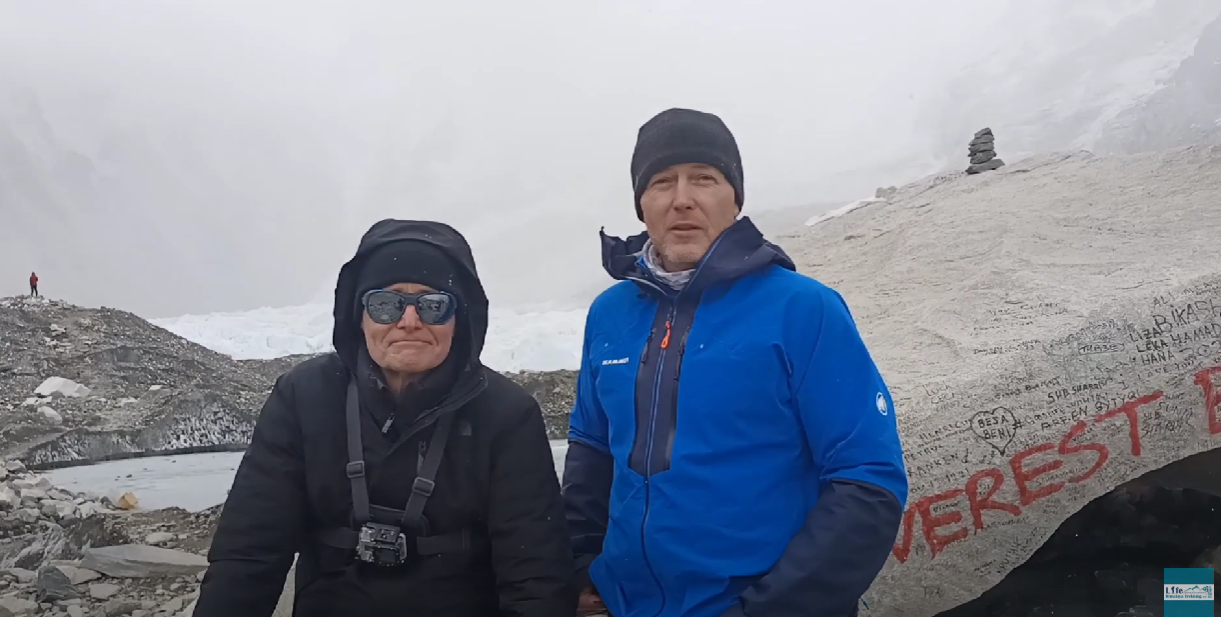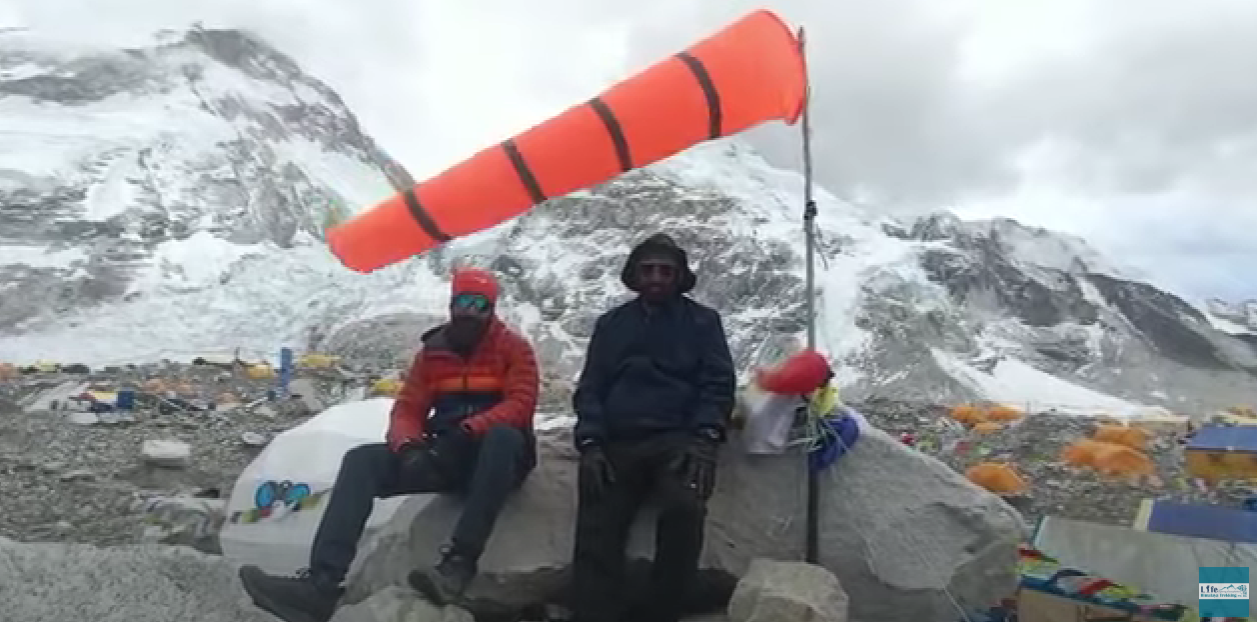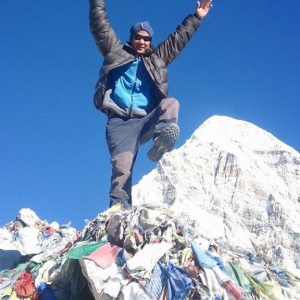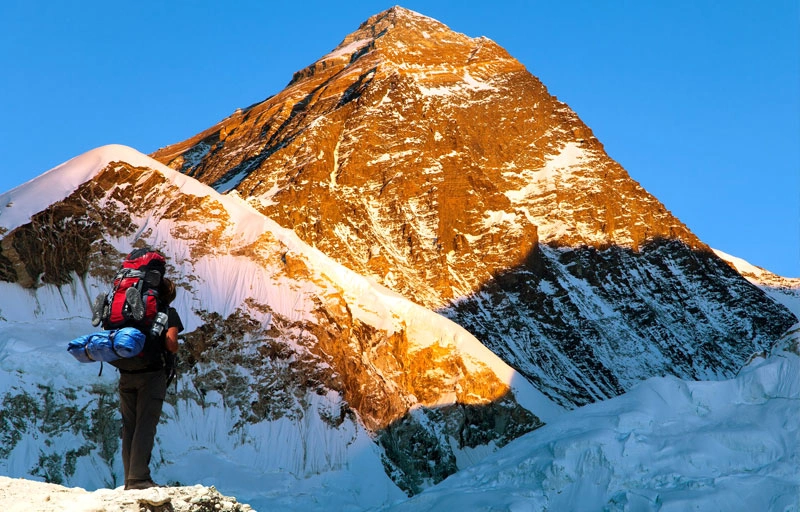Max. Altitude
6476m
Best Season
Oct-Dec & Mar-May
Activity
Peak Climbing Packages
Start / End Point
Kathmandu/Kathmandu
Mera Peak Climbing Overview
Mera Peak is one of Nepal’s tallest and most popular trekking peaks. It is in the Mahalangur section of Nepal's Solukhumbu region. It stands at an altitude of 6,476 m and is considered a non-technical trekking peak, as the snow slopes do not exceed 30 degrees. Thus, it has emerged as one of the suitable trekking peaks for beginners who want to pursue a career in mountaineering. The Mera peak climbing passes through the south of Lukla to the traditional village of Kote, Thangnak, and Khare and takes place within the Makalu Barun National Park.
Mera Peak Climbing includes three primary subsidiary peaks. They are Mera Central (6,461m), Mera North (6,476 m), and Mera South (6,065 m). The peak is popular among tourists, particularly those seeking adventure. However, the Mera Peak North is the most preferred mountain to climb as it is comparatively easier than the other two peaks. Additionally, it offers a spectacular view of various mountains above 8,000 meters, including Mount Everest, Mount Makalu, Mount Cho Oyu, and Mount Lhotse from its summit.
Highlights of Mera Peak Climbing
- Climb Nepal’s highest trekking peak, Mera Peak, which stands at 6,476 m (21,247 ft).
- 360-degree panoramic views of the world’s highest mountains from the summit point of Mera Peak, including Mt Everest, Lhotse, and Cho Oyu.
- You’ll experience an incredible combination of both climbing and trekking in the remote Hinku Valley, part of the Makalu Barun National Park.
- You’ll explore highland villages and settlements, where you’ll experience their unique lifestyle, culture, and traditions.
- A remarkable walk through untouched and remote valleys, as well as colorful Rhododendron forests.
- You’ll experience the combined tea houses and Camping accommodation, which will provide you with an authentic Himalayan experience.
- Get one of the best hospitality from local guides and Sherpa settlements.
- You’ll cross one of the challenging Zatrwa La Passes (4,610 meters) on the way to Mera Peak.
How Tough is the Mera Peak Expedition?
Mera Peak Climbing is an Alpine Grade PD, meaning it is of moderate difficulty, requiring basic technical skills such as glacier walking, rope handling, and the use of crampons and ice axes. Despite being known as a suitable climbing expedition for beginners, some challenging ascents on the expedition require the use of mountaineering equipment. This peak is a preparatory climb for higher Himalayan peaks in the Everest region expeditions. Similarly, the chances of altitude sickness are very high as you will be reaching an altitude of 6,476 m above sea level. Walking on glaciers with some steep areas and potential crevasse risks, as well as steep snow slopes, are other tough challenges when climbing Mera Peak.
Therefore, we recommend that you come with a decent level of physical fitness and mental fortitude. Our guides and crew members will assist you through some strenuous paths and help you use your gear effectively. The climbs and walks vary between 5 to 8 hours a day. Our guides will ensure proper acclimatization when necessary. They will inform you about the difficulties and conditions throughout your trek. Ensure you comply and approach the trip with an open mind for an optimal experience.
Mera Peak Climbing Itinerary
01
Arrival in Kathmandu and transfer to Hotel
Your first day of Mera Peak climbing begins with your arrival in Kathmandu, Nepal, at Tribhuvan International Airport. You will be warmly received and greeted by a Life Himalaya Trekking representative and then transferred to your hotels in Kathmandu. After checking into your hotel rooms and getting refreshed for the rest of the day, you may have a short excursion to the main places of Kathmandu.
In the evening, you will be introduced to your trek guide and attend a trip briefing session at our Life Himalaya Trekking office in Thamel. Then, you’ll have a welcome dinner hosted by us at a typical Nepalese Restaurant, where you can enjoy and taste authentic Nepalese cuisine. Overnight stay at a 3-star-rated Hotel in Kathmandu.
Maximum Altitude
1,320 m.
Meals
N/A
Trek Duration
15 min Drive
Accomodations
3 Star Hotel
02
Sightseeing tour at Kathmandu valley and trip preparation

It is a free day in Kathmandu after your long flight from your home country. On the second day of the trip, you will visit some of the historical places, including Pashupatinath, Swyambhunath, and Buddhanilkantha, as well as culturally significant places such as Kathmandu Durbar Square, Patan Durbar Square, and Bhaktapur Durbar Square.
In the evening, you will attend a briefing session where our trekking and climbing guide will provide a brief overview of the trip and discuss trip preparation. Overnight stay at a 3-star-rated Hotel in Kathmandu.
Maximum Altitude
1,320 m.
Meals
Breakfast
Accomodations
3 Star Hotel
03
Connect fly to Lukla & trek to Paiya (Chutok)

Today, we will travel from Kathmandu to Lukla by a 35-minute flight. If you are new to flying, it might be one of the best experiences of your life, as you will witness the spectacular scenery of mountain ranges and lush forests from an altitude of over 2,800 m. Here at Lukla, we will introduce you to our Porters and crew members.
After a brief meeting and introduction with the porters, we begin our trekking journey through the off-the-beaten-path route of the Everest region, passing through jungle sections, crossing the Handi Khola, and following typical Sherpa villages and green valleys towards Surke village. Then we continue our trek, taking in the beautiful view of Kongde Ri, and cross the Chutok La before reaching the small settlement of Paiya (Chutok). Overnight stay at a tea-house in Paiya (Chutok).
Maximum Altitude
2,730 m.
Meals
Breakfast, Lunch and Dinner
Trek Duration
6 hours Walking
Accomodations
Lodge
Transportation
35 min Flight
04
Trek from Paiya to Panggom
Our day begins after having breakfast at the teahouse. Today, our trek begins to descend steeply. We cross the beautiful village of Paiya, leaving the Khumbu region and entering the Hinku Valley. From here, the pathways remain slippery until we cross the Kari La Pass. We walk through rhododendron and bamboo forests on narrow mountain sections with incredible views of the mountains.
Then we continue our trek to Panggom village, where the typical Sherpa people used to farm. Finally, after a short trek, you will reach the beautiful village of Panggom, where you will stay overnight.
Maximum Altitude
2,804 m.
Meals
Breakfast, Lunch and Dinner
Trek Duration
6 hours Walk
Accomodations
Lodge
05
Trek from Panggom to Ningsow
After having breakfast at Panggom, we will continue our journey toward Ningsow. After a short trek from Panggom, we will reach Panggom La Pass, where you will briefly need to climb a hill. You will then cross the Peseng Kharka River and climb Peseng Kharka Danda, just north of the river. You will be soaking in all the mesmerizing views of nature as you descend toward Ningsow Village, where you will stay overnight.
Maximum Altitude
2,863 m.
Meals
Breakfast, Lunch and Dinner
Trek Duration
5 hours Walk
Accomodations
Lodge
06
Trek from Ningsow to Chhetra Khola
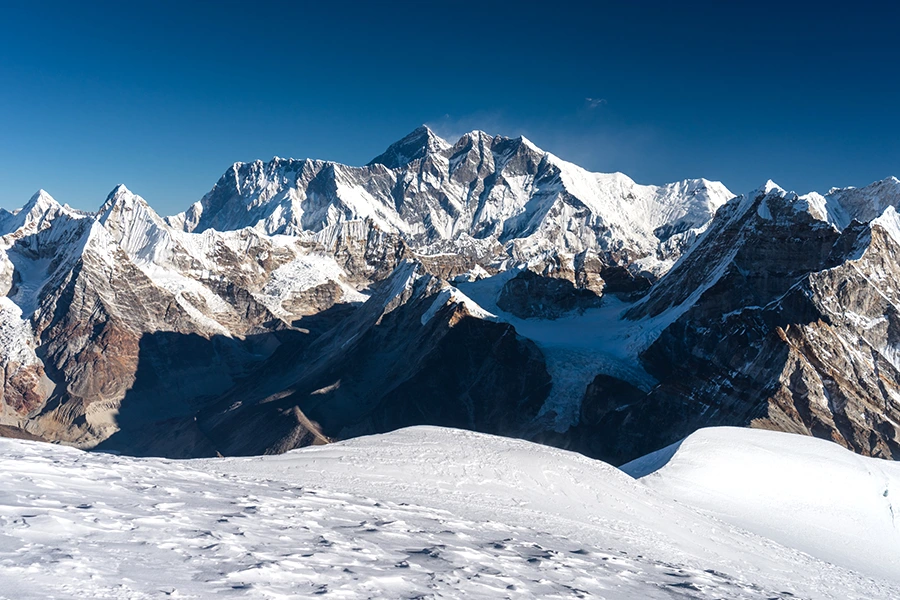
We take our breakfast at a teahouse in Ningsow and continue our trek early in the morning. Our walk moves forward and climbs hills from Ningsow, then descends for a while. Then we climb some more to reach Ramailo Dana, from where we can witness the outstanding views of Mera Peak and Salpa. After ascending and descending our route, we enter the Makalu Barun National Park. On the way, we might even come across the elusive Red Panda. Overnight stay at a tea house in Chhetra Khola.
Maximum Altitude
3,122 m.
Meals
Breakfast, Lunch and Dinner
Trek Duration
8 hours Walk
Accomodations
Lodge
07
Trek from Chhetra Khola to Kothe
After breakfast at Chhetra Khola, the Mera Peak climbing journey begins with a walk through a green forest, featuring steep downhill sections. We walk north along the main pathways to Mera Peak. The route is quite straight, running along the bank of the Hinku River. After walking for some time, you will arrive at the Tashing Ongma, where you can enjoy a delicious herbal tea.
Once you’ve taken a short break, you can continue toward Sanu Khola, and from there, Kothe is just a short distance across the bridge. Your day’s overnight is at Kothe.
Maximum Altitude
3,580 m.
Meals
Breakfast, Lunch and Dinner
Trek Duration
7 hours Walk
Accomodations
Lodge
08
Trek from Kothe to Thangnag

The night in Kothe will remain in your memory forever; however, it’s time to move forward. Today is the day you will make significant progress towards Mera Peak by reaching the Thangnak village. From the bank of the Hinku River, you will move towards Gondishung, located right below the highest peak of Mera, where you’ll have your lunch.
After lunch, you will make your way towards Lungsumgba Gompa, an over 200-year-old Buddhist monastery. You will be advised to pray and light a shrine in the Gampa to receive the blessing and ensure the success of your expedition. Once you make your way to Thangnak, you will find one of the best paths for trekking, and the road is also quite easy to walk, so you will get a once-in-a-lifetime experience accompanied by truly scenic beauty around you. After a couple of hours, you will arrive at Thangnak, where you will spend the night.
Maximum Altitude
4,358 m.
Meals
Breakfast, Lunch and Dinner
Trek Duration
5 hours Walk
Accomodations
Lodge
09
Trek from Thangnag to Khare Camp
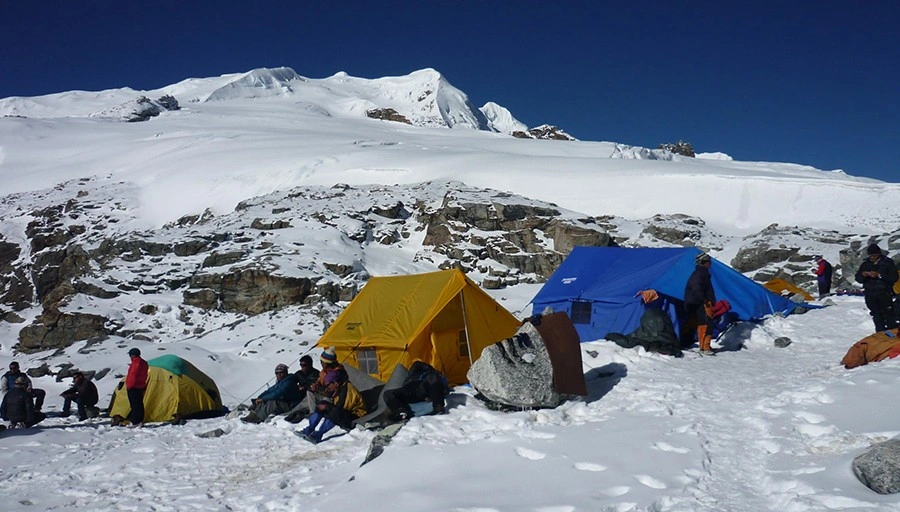
Another challenging trek awaits you after moving ahead of Thangnak to reach today’s destination, Khare. You will have to walk through steep hills and glacier-filled, slippery roads, so you must be very careful. Once you reach Charpate Himal, you will have to descend one more steep hill to reach Khare, another village on Mera Peak’s lap.
Khare is a small, basic settlement, offering many sightseeing places. From here, we can see the northern face of Mera Peak, which will be an amazing experience. After lunch, we can hike around Khare Camp. You will stay overnight at Khare and, the next day, prepare for the Mera Peak climbing training.
Maximum Altitude
5,045 m
Meals
Breakfast, Lunch and Dinner
Trek Duration
5 hours Walk
Accomodations
Lodge
10
Acclimatization day at Khare Camp and Pre-climbing training up to Mera Base Camp

This is the day to take a break from walking and climbing to ensure proper altitude acclimatization. The expert guides and sherpas will provide fundamental training and instruction in climbing skills, as well as a brief overview of the necessary climbing equipment. Climbing high and sleeping low is considered a good way to acclimate your body, reducing the likelihood of altitude sickness problems during your trip. Today, we will also have basic training to prepare ourselves better for the Mera Peak climb.
Your peak climbing guide will help you with basic climbing techniques and demonstrate the best ways to use your climbing gear, including ice axes, harnesses, ascenders, and crampons. The training will also include learning the best climbing technique with the rope, where we will be pre-climbing training near Khare. Likewise, you will need plenty of rest on the day as from tomorrow, the hiking and trekking will be relentless and regular. Overnight stay at a tea house in Khare Camp.
Maximum Altitude
5,350 m.
Meals
Breakfast, Lunch and Dinner
Trek Duration
4 hours Walk
11
Climb from Khare Camp to Mera High Camp
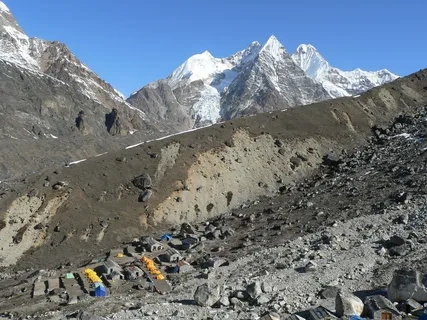
You can finally see the destination on-site as you travel from Khare toward Mera Base Camp. On the day, you must start your trek early in the morning, as you will need to move slowly, which will take longer. You will have to make your way through steep, slippery hills through Mera Glacier, so it is necessary to be very careful. After 3-4 hours of trek, you will reach the Mera Base Camp and spend the night at the camp made by Sherpas. This will be another surreal experience, as you will sleep under the beautiful stars after enjoying delicious food made by locals.
Maximum Altitude
5,780 m.
Meals
Breakfast, Lunch and Dinner
Trek Duration
7 hours Walk
Accomodations
Camping
12
Climb from Mera High Camp to Summit Mera Central At 6,476 metres (21,247 ft) and back to Khare Camp

Today, you will reach the summit, the ultimate destination of your trek. On the day, you have to start very early, around 2 AM, and begin moving forward. This is because locals recommend reaching the summit before noon, as the chances of strong winds start in the afternoon, which will hamper the expedition. It’s going to be very cold in the beginning, but soon we warm up as we continue up the glacier and onto a peculiar ridge.
You will have to make your way from Mera La Pass, and the road is equally steep and slippery as before. Therefore, local guides and experts will constantly remind you to be careful and take slow steps while moving forward. The duration of this trek is typically 3 to 4 hours. However, occasionally, factors such as route conditions, weather, and other variables may extend the time required to reach Mera High Camp by up to 7 hours. An experienced guide will lead you on the final path, and you must follow them slowly and steadily to reach the destination.
After reaching the top of Mera Peak, you will feel successful and overwhelmed with joy, and another breathtaking view of the mountain range awaits you. You’ll be captivated by the breathtaking views of the mountain routes, including Everest, Lhotse, and Cho Oyu, leaving you in wonder. We spend a short time at the summit and then take our steps back to the high camp, where we rest for a while before descending along the same route back to Khare via Mera base camp. Overnight stay at a tea house in Khare Camp.
Maximum Altitude
6476 m.
Meals
Breakfast, Lunch and Dinner
Trek Duration
9 hours Walk
Accomodations
Lodge
13
Reserve day for Contingency or extra day for summit in case of bad weather.
There is no guarantee that we will have favorable weather on our planned day for the summit. Therefore, this day is set aside as a contingency in case we cannot submit the Mera on the expected day due to bad weather conditions or other unexpected reasons. This day is reserved for such risks in our adventurous journey to Mera Peak climbing. However, this day will not be required if the trip goes smoothly.
Maximum Altitude
5,045 m.
Meals
Breakfast, Lunch and Dinner
Accomodations
Lodge
14
Trek from Khare Camp to Kothe
Our day begins after breakfast at Khare Camp. We start trekking down the Hinku Valley today. We trek from Khare to Kothe along the same route we used previously.
Then we slowly descend, enjoying the breathtaking Himalayan vistas toward the beautiful settlement of Kothe. Kothe is famous for its local homemade delicacies and wines. Overnight stay at a tea house in Kothe.
Maximum Altitude
3,580 m.
Meals
Breakfast, Lunch and Dinner
Trek Duration
5 hours Walk
Accomodations
Lodge
15
Trek from Kothe to Thuli Kharka
Today, we retrace our trek to Thuli Kharka after breakfast. The pathway passes through the rhododendron forest and goes uphill on the very first sections. We climb up and descend, crossing several tributaries of the Inkhu Khola before reaching a forked section near Taktho. Then, we take the walkway that passes by the Chorten, after which we walk downhill on steep sections to reach the Thuli Kharka valley. Overnight stay at a tea house in Thuli Kharka.
Maximum Altitude
4,320 m.
Meals
Breakfast, Lunch and Dinner
Trek Duration
6 hours Walk
Accomodations
Lodge
16
Trek from Thuli kharka to Lukla
On the sixteenth day, you will descend from Thuli Kharka to Lukla via the massive Zatrwa-La Pass. You will still be in the company of incredible mountains, mainly Cho Oyu, Numbur Himal, Kusum Khangru, and other mighty peaks. You will descend to Chutang and then enter the magnificent Lukla, where you will stay overnight and rest before flying to Kathmandu tomorrow.
Maximum Altitude
4,610 m.
Meals
Breakfast, Lunch and Dinner
Trek Duration
7 hours Walk
Accomodations
Lodge
17
Fly back to Kathmandu
Today is the last day with your Sherpa porter and crew members, so if you are satisfied with their services, you may want to express your gratitude. Then we take the earliest possible flight back to Kathmandu, carrying with us the long-lasting memories of our successful trip completion. We enjoy a short and scenic 35-minute, breathtaking flight to Kathmandu.
Upon your arrival at the domestic Airport in Kathmandu, our representative or guide will take you to your respective hotels, where you can relax and rest. The rest of the day is reserved for your activities, such as souvenir shopping, massage, and city tours. Overnight stay at a 3-star hotel in Kathmandu.
Maximum Altitude
1,320 m.
Meals
Breakfast, Lunch and Dinner
Accomodations
Lodge
Transportation
35 mins Flight
18
Farewell and Final Departure
This is the final day of the trek and the day of departure. You will check out of the hotel and transfer to the airport. We hope your journey has been memorable, and we look forward to seeing you again. If you have more time and a willingness to participate in other activities, such as rafting, Jungle Safaris, Paragliding, and Bungee Jumping, as well as tours in famous cities in Nepal, then we will assist you according to your recommendations.
Maximum Altitude
1,320 m.
Meals
Breakfast
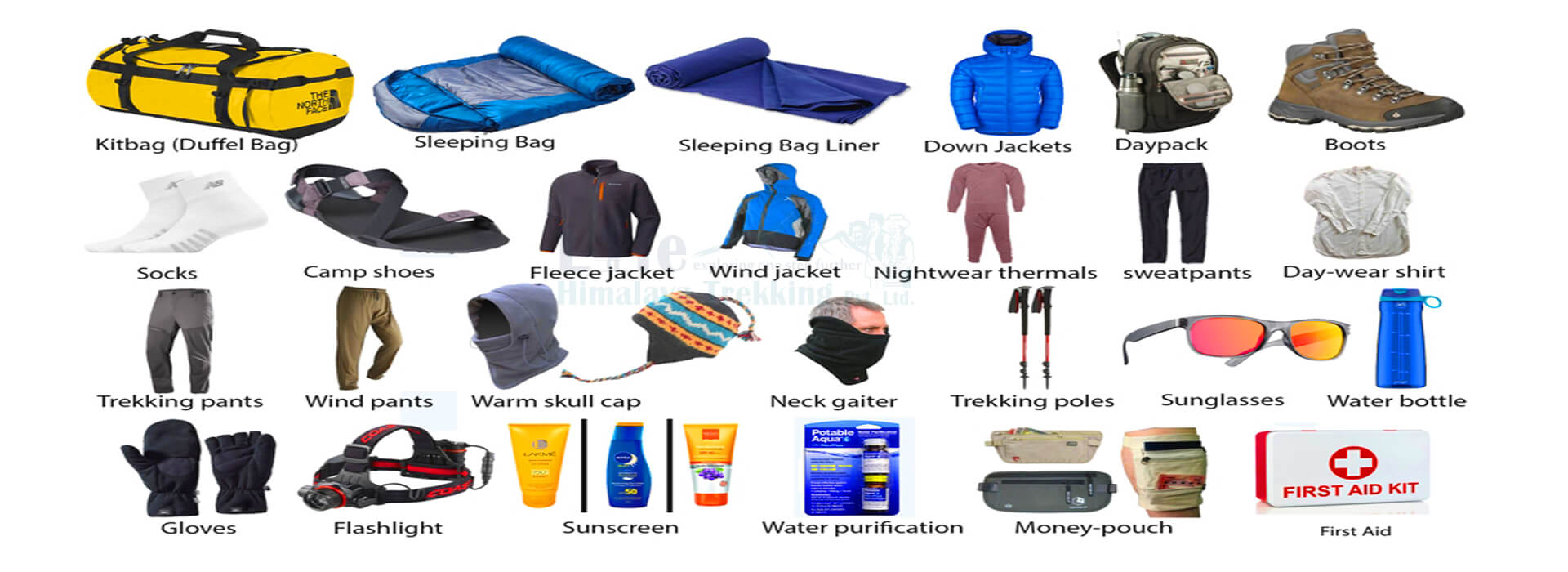

Required Equipments for Trekking in Nepal
- Breathable Underwear
- Sports Bra
- Base Layers
- Trekking Shirts
- Trekking Trousers and Shorts
- Fleece Jacket
- Down jacket (insulated jacket)
- Windcheater (water proof)
- Sun protection Hat
- Headband or Beanie
- Scarf or neckband
- Gloves (inner and outer )
- Hiking Boots
- Trekking Shoes
- Hiking Socks
- Thermal Socks
- Gaiters
- Duffel Bag
- Day pack
- Sleeping Bag
- Trekking poles
- Sunglasses
- Hydration bladder or Water bottle
- Head Lamps
- Batteries
- Personal towel
- Swiss army knife
- Sun lotion
- Medical & first-aid kit
- Woolen socks
- Waterproof jacket
- Lip Guard
- Insulated pants
- Baby wipers
Required Equipments for Climbing in Nepal
- Water bottle
- Batteries and bulbs
- Flashlight
- Personal towel
- Swiss army knife
- Rucksack
- Sun lotion
- Medical & first-aid kit
- Sewing kit
- Polypropylene/wool socks
- Other required equipment
- Sleeping bag
- Down Jacket
- Waterproof jacket
- Trekking shoes/boots
- Camp shoes
- Jumperorpile jacket
- Hiking pants
- Hiking shirts
- Full–sleeves shirt
- T-shirts
- Sun hat
- Gloves
- Woolen hat
- Long underwear
- Goggles or sun glasses
- Gaiters
- Sun block for lips
- Light cotton socks
- Mountain trekking boots
- Woolen socks to wear with boots
- Nylon wind breaker
- Insulated pants
- Nylon wind pants
- Long sleeved cotton/woolen shirts
- Sun hat
- Long cotton hiking shorts
- Fleece/wool for climbing
- Lightweight fleece
- Sleeping pad (karri mat) or thermarest
- Down high altitude sleeping bag
- Down jacket/trousers/vest
- Light cotton athletic socks and wool socks
- Water proof climbing jacket
- Head torch/batteries/bulbs
- Climbing sunglasses
- Lightweight thermal/insulated ski gloves
- Sun screen
- Warm climbing trousers
- Wool long underwear
- Other required equipment
- Climbing boots
- Gaiters
- Ice axe
- Harness
- Crampons
- Karabiners
- Tapes/slings
- Snow bars
- Ice screws
- Rock pegs
- Deadmen
- Crash hat
- Day bag
- Rucksack
- Lip salve
- T-shirts
- Ascenders
- Ascenders
- Kit bag
Whats Included
- Airport picks up and drops international and domestic.
- Complete departure information about the trek, flight ticket, guide, altitude sickness, and reconfirmation and extend visa service (if necessary) and extra tour service before the trek starts.
- 3 nights 3 star hotel in Kathmandu with breakfast. or similar.
- Flight From Kathmandu to Lukla to Kathmandu only 15 kg luggage aloud (10 kg big bag & 5 kg hand bag)
- Trip flight from Kathmandu to Lukla & Kathmandu for members and involved staff.
- Private transportation picks up and drops.
- Best Lodge accommodation & full board meals throughout the trek
- Hot tea and coffee in a cup with each meal
- Breakfast, Lunch, and Dinner included ,chosen from the lodge menu
- 14 Nights of twin share accommodation during the trek.
- As per group size experience, government license holder trek guide, helpful and friendly strong, porters (1 porter for 2 people) and their food, accommodation, salary, equipment, and accidental insurance for all staff (5 trekkers 1 assistant guide)
- A warm Down jacket and four seasonal sleeping bags will be provided during the Climbing (down jacket and sleeping bag are to be returned after the trip )
- TIMS Fee- Trekkers’ Information Management System (Please bring 2 passport-size photos for permits)
- Mera peak climbing permit fee
- First Aid kits with oxi-meters for the staff and the groups
- Mera peak trail map, Life Himalaya printed duffel bag and T-shirts
- Services coordination for emergency and rescue operations
- Government taxes & office service charge
- Farewell dinner at a reputed restaurant
- Achievements Certificates
Whats Excluded
- Meals not quantified in the ‘Meal Inclusions’ in the itinerary
- Travel Insurance
- International airfare
- Nepal entry visa charge.
- All beverages and other personal expenses.
- Snacks and other personal expenses
- Hot shower during the trek.
Mera Peak Climbing Trip Information
Addon Options on Mera Peak Climbing
Upgrade options for Accommodation in Kathmandu
For our Mera Peak climbing expedition, Life Himalaya Trekking offers you Kathmandu accommodation in a well-rated three-star hotel. You will get a double room with hot water, an attached bath and shower, along with WiFi.
However, if you think our accommodation arrangement somehow falls short of your expectations, then we also offer you an upgrade option. You can upgrade to a single personal room or select a higher-category hotel that aligns with your desire.
There are several selection options in Kathmandu from four to five-star luxurious hotels that are known for their outstanding services, utilities following international standards.
From private pool, fitness center, suite, and deluxe rooms, elegant furnishings and decor, 24-hour on-call staff service, garden, balcony, to game rooms and lounges, you will have everything at your service.
We request you to kindly inform us about your expectations beforehand so we can prearrange the preference you so desire. Please understand that this service will be available at an additional charge based on the selection you make.
Upgrade your Lukla Departure with a Helicopter Flight
We present you a fantastic opportunity to reach Lukla, a travel mode that will take you away from the crowd of typical travelers and make you an extraordinary adventurer.
With a helicopter flight between Kathmandu and Lukla, you will have a short, stylish, and luxurious journey. And, if you choose to travel privately, it will be even more fantastic, where you will be able to add a personal touch to your remarkable Mera Peak climbing expedition.
With this option, you can simply forget about waiting at the airport for ideal weather. You can even dismiss the detour towards Ramechhap, a stressful four-hour-long road trip at midnight.
One notification from you and we will be flying you above the grand profiles of Everest to Lukla or Kathmandu in a matter of minutes. Please do not forget to inform us in advance so we can ensure your Mera Peak climbing expedition in a true sense is truly exceptional.
How Mera Peak Climbing Journey Starts
Mera Peak Climbing begins with a sightseeing tour of the historical Kathmandu city. Then, our trip is followed by a scenic flight to Lukla. It is the gateway of the entire Everest Region from Kathmandu. After landing at Lukla airstrip, we begin our Mera Peak Climbing Journey with the trek. We head through a less crowded, terraced landscape and less-traveled valleys. Our journey takes us to the charming village of Paiya, home to a mix of Sherpa and Rai people. Then, the trek follows some of the most beautiful habitats toward Panggom Valley.
Continuing our journey, we pass through the untouched valleys of Ningsow and Chetrekhola. Next, we trek to Kothe and Thangnag and towards Khare Camp. We stop at Khare Camp to ensure proper altitude acclimatization, allowing us to stay active. We walk past frozen waterfalls and amazing glaciers. We will be greeted by breathtaking Himalayan vistas on our way to Mera High Camp. We attempt a final climb to the summit of Mera Central Peak. The summit day starts early in the morning when we ascend toward the summit point via the northern route.
We make a gradual ascent, equipped with proper climbing gear. Considering the weather, we follow the guidance of our experienced climbing experts to reach the summit of Mera Peak. From the Mera Peak summit, we will be able to see the outstanding panoramic views of Mt. Everest, Kanchenjunga, Makalu, Baruntse, Nuptse, Lhotse, Ama Dablam, Cho Oyu, and many other peaks in the Everest region. We spend a short time at the summit and descend the same route back to Khare via Mera Base Camp. After a successful summit of Mera Peak, we descend gradually through Kothe, Thulikharka, and via Zatrwa La Pass back to Lukla. Then, we again take a scenic flight back to Kathmandu.
Best Season for Mera Peak Climbing
Mera Peak Climbing is a seasonal adventure. Spring and Autumn are the optimal seasons to take this journey (March to May and September to November). During these seasons, the weather is clear, and the mountain scenery is mesmerizing. Moreover, the weather is stable during these months, making it relatively safe for mountain climbing. Furthermore, October is quite attractive to tourists, as the weather is chilly but not extremely cold, and there is a lower chance of leeches and landslides.
The Monsoon season is considered the worst time for Mera Peak Climbing due to continuous rain and an increased chance of avalanches. Likewise, winter is also less favourable as there will be excessive snowfall in the Himalayas during this time. The weather will be extremely cold, making it a tough time to climb mountains or trek at higher altitudes.
Mera Peak Climbing Difficulties
Altitude Sickness
Since Mera Peak is higher than 6000m, many people face difficulties with altitude sickness. This is mainly because, at the top altitude, there is a limited oxygen supply, and changes in altitude can cause numerous health problems. This is the primary difficulty for trekkers and climbers, as it can worsen rapidly if left untreated, potentially developing into High Altitude Pulmonary Edema (HAPE) or High Altitude Cerebral Edema (HACE).
Longer Walking Days
Another significant difficulty of the Mera Peak Climbing is the longer walking days with longer trekking hours. The journey takes approximately 16-18 days, round trip, with each day involving walking for 5-6 hours and sometimes longer on the main summit day. Thus, trekking for such long days will physically and mentally exhaust the climber, adding to the difficulty of the climb.
Harsh Weather Conditions
The weather in the Himalayas is unpredictable, and it can change in no time. Another difficulty that trekkers might face while climbing Mera Peak is the harsh and constantly changing weather conditions. At high altitudes, climbers face cold temperatures (often below -15°C), strong winds, and the possibility of snowstorms, especially in late autumn and early spring.
Physical Fitness
Physical fitness is a key requirement for trekking and mountain climbing. If you are unfit, it can cause significant difficulty climbing, especially for Mera Peak, as it is a long and challenging ascent. The climbers need to prepare for the climb even three to six months before the actual date. If you lack physical fitness, it can cause a hindrance not only to you but also to your trekking team.
Language and Cultural Barriers
One of the most common difficulties during Mera Peak Climbing is the language and cultural barriers for tourists from other countries. This is why it is recommended that trekkers hire guides or a local person in the area to safely guide them to the peak. However, if you are alone and do not understand the language and culture of the local area, it can cause real difficulty while trekking, and you might be left without any plan for the future. Hence, these are the main difficulties that can arise during Mera Peak Climbing.
Mera Peak Climb is an Ideal Adventure for Beginners
Mera Peak climbing attracts beginner climbers who possess strong physical fitness and have received basic training in glacier travel. It offers an excellent opportunity for beginners to test their skills. Exploring the Mera range allows beginners to build a strong foundation for future expeditions.. The journey offers stunning views and a unique experience for aspiring climbers. During Peak climbing, climbers can get valuable skills and build confidence. Beginners can learn how to use climbing gear during their Mera Peak climbing experience. They also get the basics of ascending and descending. The experience prepares them for more challenging mountain climbing in the future.
Yet, the route to Mera Peak climbing is challenging trip and requires proper preparation. If you cannot handle altitudes above 4000 m, this trekking route may not be suitable for you. Climbers on this route often spend several days at altitudes exceeding 5,000 m and summit at 6,476 m.
Yet, you don’t need prior peak climbing experience to go on a Mera Peak climbing adventure. But being mentally and physically fit will enhance your enjoyment even as a beginner. Although it is a popular choice among beginners, it shouldn’t be underestimated and requires proper training, fitness, and guided support.
Food and Accommodations available during Peak Climbing
Food
Our package trip to Mera Peak Climbing includes all meals, i.e., Breakfast, Lunch, and Dinner, during the entire trekking period. You will have dinner and Breakfast at the same tea house where we spent overnight, and Lunch will be en route to the next destination. While on your Mera Peak Climbing trip, you can enjoy the typical Nepalese cuisine (Dal Bhat and Tarkari) and limited menu options, such as Tibetan bread, noodles, momos, and simple Western dishes. During breakfast, you can enjoy Masala tea, hot chocolate, bread, omelets, porridge, and snacks, as well as drink options of hot water and tea.
During the camping period, while we are in Mera Peak Base Camp and Mera High Camp, our kitchen team will prepare hygienic food to serve you. At Mera Base Camp and High Camp, expect simple meals such as rice, lentils, soup, and tea, as porters carry all supplies. Still, we are confident that we will provide the best facilities and services.
NOTE: If you have any dietary restrictions or allergies, please let us know in advance, as we will try to accommodate them.
Accommodations
Life Himalaya Trekking provides standard accommodation during your trip to Mera Peak clmbing. We will provide the best lodging with a comfortable environment available to ensure your satisfaction on this trip.
As per our Mera Peak Climbing package, we have quoted this cost, which includes 04 nights in a 3-star Hotel during the night stay in Kathmandu and the best available teahouses in the Himalayas. The tea houses have basic rooms with twin beds, blankets, and shared toilets.
During the three-day climbing period (including acclimatization day), we will set up the tented camps. At camps, sleeping tents and a dining tent are provided, but there is no running water or toilet facilities. Therefore, portable toilets are used at camps.
Required Permits for Mera Peak Climb
You will need a Mera Peak Expedition Permit to climb Mera Peak. Besides that, you will also need the Makalu Barun National Park Permit and the Khumbu Pasang Lhamu Rural Municipality Permit. The climbing fee permit for the Mera Peak varies in distinct seasons. You can get the climbing permit from the Nepal Mountaineering Association in Kathmandu or contact any registered trekking agency for it.
Cost of Mera Peak Expedition Permit:
| Season | Cost (per person) |
| Spring (March to May) | USD 250 |
| Summer (June to August) | USD 70 |
| Autumn (September to November) | USD 125 |
| Winter (December to February) | USD 70 |
Cost of Makalu Barun National Park Permit:
| Cost for SAARC Nationals | Cost for Other Nationals |
| 1,500 NPR | 3,000 NPR |
Cost of Khumbu Pasang Lhamu Rural Municipality Permit:
| Cost for SAARC Nationals | Cost for Other Nationals |
| US $15 | $7.50 |
Transportation during Mera Peak Climbing
Throughout the journey to the Mera Peak Expedition, you’ll take various modes of transportation, including both ground and air. During your sightseeing tour in Kathmandu, you will be provided with the best private vehicles for a day trip (car, van, or bus, depending on the group size). Likewise, your pick-and-drop service within the Kathmandu Valley will be provided in a car or a Van.
Furthermore, there are scheduled domestic flights using small aircraft such as Twin Otter or Dornier planes on round-trip flights between Kathmandu and Lukla, which include a 35-minute short and scenic flyover above the Himalayas. The domestic flight to Lukla marks the beginning of the Mera Peak expedition.
Safety and Security During the Mera Peak Climb
Life Himalaya Trekking, a local travel and trekking agency, has operated the best and finest Mera Peak Climbing since our establishment, prioritizing safety and security. This special Mera Peak climbing will be accompanied by our experienced English-speaking guide, who has an outstanding ability to handle challenging situations with good manners and is hospitable, as well as porters. They accompany you from the start of your journey, ensuring proper acclimatization, monitoring your health, and guiding you safely throughout the trek and the climb.
During the climbing period, our dedicated camping teams will also assist with your lodging, setting up camps, and preparing nutritious meals. Likewise, for your safe and secure climb, our team uses essential safety equipment, including first aid kits, satellite phones, and climbing gear. Likewise, our Kathmandu office team maintains 24/7 service with the climbing team to provide service whenever needed. Additionally, we have emergency evacuation plans in place for your safety and security along the Mera Peak, as your safety is our priority.
Rescue by Helicopter:
At high altitudes, the density of oxygen is minimal. However, you do not have to worry if you get sick or injured at any point during the Mera Peak Climb; we have a well-trained guide who will provide primary first aid, so they will be able to assist you. If primary assistance can’t help, Life Himalaya Trekking offers emergency rescue facilities by Helicopter at any point and transports individuals to the hospital for treatment.
Physical Fitness and Experience Required For Mera Peak Climb
Climbing Mera Peak is generally non-technical but is regarded as Alpine PD (Peu Difficile), which means climbers should expect to encounter steep climbing, glacier walking, and snow-covered sections. Thus, a previous experience of climbing is a plus point for the climb. Likewise, knowing the necessary climbing equipment and gear can significantly assist you during this adventurous trip. Still, the trip is ideal for adventure-motivated climbers who are comfortable walking on snow ridges.
To be physically fit, we recommend that climbers engage in training for at least 3 to 6 months prior to the expedition. For the journey, climbers should engage in cardiovascular exercises (2–3 times per week), such as running, hiking, or cycling, as well as strength training (2–3 times per week) that focuses on strengthening the legs, core, and upper body. Similarly, mental preparedness is equally crucial for completing the expedition.
Mental preparedness encompasses a positive mindset, practical goal setting, motivation, and discipline. Additionally, some basic technical skills preparation, including the use of crampons and an ice axe, basic ropework for glacier travel, and completing a pre-expedition mountaineering course, can be beneficial when climbing Mera Peak.
Mera Peak Climbing Tips
Strong Physical Fitness
A good physique is one of the most essential things for a mountaineering expedition. The Mera Peak presents you with several challenges during its expedition. It is essential that you’re in good shape to ascend the Mera Peak successfully. You should focus on improving your cardiovascular endurance and stamina. It would be beneficial to engage in weighted hikes, stair climbing, and endurance treks that help you improve your physique.
Opt for the Best Season
Climbing high-altitude peaks comes with risk. It is essential that you pick the right season to ensure a safe climbing experience. The seasons of Autumn and Spring are considered the ideal time for mountaineering in Nepal. The weather in the Himalayas is unpredictable, and conditions can change rapidly. Compared to other seasons, the weather is quite stable during Spring and Autumn. Likewise, the temperature is moderate, providing ideal conditions for mountaineering. Moreover, avoid the summer and winter seasons as they pose risks.
Go on Prior Hikes or Treks
Going on prior hikes or treks will provide you with the high-altitude experience you need to prepare for climbing Mera Peak. Prior hikes will help you understand the challenges of walking in high altitudes. Likewise, hiking or trekking will help you improve your stamina. Similarly, we suggest that you take a guided glacier training and rock climbing to build confidence on snow and ice terrain.
Acclimatize Properly
Altitude sickness is one of the major concerns while trekking in the Himalayas. The oxygen availability drops above 2,500 meters, starting to increase the risk of altitude sickness. The Mera Peak climb takes you to an elevation of 6,467 meters above sea level, where the oxygen level is significantly lower compared to normal elevations. Thus, the chances of catching altitude sickness are very high. This is why you need to acclimate properly to prevent altitude sickness. Proper acclimatization ensures that your body becomes well-adapted to the Himalayan weather, thereby reducing the risk of altitude sickness.
Use Quality Gear and Equipment
Climbing a mountain in freezing temperatures is extremely challenging. Using quality gear and equipment is essential for safe and successful mountain climbing. You should invest in durable boots, weather-resistant clothing, and reliable tools like ice axes and crampons. Ensure your backpack is comfortable and fits well. Always carry a first-aid kit, headlamp, and sufficient food and water. Check your gear beforehand to avoid surprises during the climb. Quality equipment enhances safety, keeps you comfortable, and prepares you for unpredictable mountain conditions.
Private Group with Helicopter Return and Customization
If you prefer a luxurious experience, you can gather in a private group and return via helicopter after climbing Mera Peak. This is a special offer that provides you with fantastic aerial views of the Mera region. After reaching the summit and trekking back to Khare Camp, a helicopter will be available to pick you up and escort you back to Kathmandu. Fill out the inquiry form to request a personalized trip for a private group with a helicopter return.
Our itineraries are customizable. So, if you find something that doesn’t satisfy you, you can modify it according to your preference. You can make the trip longer or shorter if you are time-bound or looking to spend more time. Please note that additional charges may apply for an extended itinerary and private group with heli return.
Local Climbing and Trekking Guides
As Mera Peak climbing demands good physical fitness, basic mountaineering skills, and readiness for high-altitude conditions, we haven’t cut any corners in providing the best climbing guides. Thus, we provide local climbing guides who hold a government license, as certified by the Nepal Mountaineering Association (NMA), for their expertise. They have guided successful summits in all seasons, facing snowstorms, avalanches, and technical glacier crossings. The amiable climbing guides will give you a short climbing lesson and help you every step of the way.
Along with the local climbing guide, we provide you with our English-speaking trekking guides who will ensure you don’t feel left out and communicate effectively. If female trekkers prefer female tour guides, we have experienced female guides ready to join the journey. Just know that Life Himalaya Trekking prioritizes your safety above anything else, and with us, you’re in safe hands.
Acclimatization Arrangement for your Mera Peak Climbing
As stated above, altitude sickness is one of the health conditions that adds to the difficulty of the Mera Peak climbing expedition. In our decades of expertise, we have seen most of the climbers (not all) developing minor conditions related to the altitude, such as headache, insomnia, numbness in extremities, nausea, and dizziness.
Although not extremely alarming, you should be conscious of these initial signs of altitude sickness. With rest, break, and adequate hydration, these early signs will diminish within a few hours to a day.
In order to facilitate your acclimatization correctly before you assault the Mera Summit, Life Himalaya Trekking has strategically placed a rest and training day at Khare, along with a pre-acclimatization tour in Kathmandu after your arrival.
Our expert climbing guide will always be monitoring your physical and mental conditioning. If he thinks your initial signs of altitude sickness have worsened or persisted, he may delay your progress for a day or two and descend you by around 500 m.
Our guide will also examine each climber’s pulse and oxygen level to ensure you are fit to attack the Mera Summit on the planned day.
Travel Insurance
Travel insurance is utterly mandatory for our Mera Peak climbing expedition; otherwise, the Nepal Mountaineering Association will refuse to issue you the climbing permit for the Mera Summit.
Remember, your standard insurance policy will not be valid, and you must have a specialized insurance policy for the mountaineering expedition in Nepal that should remain active for the entire duration of the expedition.
A right travel insurance for Mera Peak climbing expedition should include hiking and extreme mountain actions with specification of the usage of gear such as ice axes, ropes, and crampons.
The most important part is the specification of the maximum altitude you will be ultimately be reaching, which in Mera Peak climbing should be 6500 m. From this altitude, your insurance should cover the cost of the helicopter rescue, transport, and evacuation.
There should also be coverage for medical and accidental assistance, along with a standard international travel protection plan for lost or stolen luggage, gear, expanded stay, delayed or canceled flights, and trips.
Alternate Route to Mera Summit
If you are a very experienced climber and are already accustomed to the high-altitude environment, then you can also tackle the Mera peak climbing through a direct route that approaches the summit in a clockwise manner.
This route involves overcoming the gigantic altitude of the Zatrwa-La Pass (4600 m) before reaching the Mera Summit. Through Chutanga and Thuli Kharka, you will traverse this Pass and connect with the route proceeding towards Kothe.
Please be aware that this route is more rapid, straight, and increasingly takes you to higher elevations in a short amount of time.
Expansion options for Mera Peak Climbing
Connect your Mera Peak Climbing with Everest Base Camp
You can also connect your Mera Peak climbing route with the Everest Base Camp trek, which will elevate your adventure to new heights of excitement and wonder.
If you choose to integrate the Everest Base Camp trek, you will first walk on the classic Everest route that will advance you to the base camp beneath Everest at 5364 m.
After you reach the 5644 m summit of Kala Patthar, your trail will then march you to Pheriche, from where you can either trek or take a helicopter ride to Khare, thus setting the stage for your Mera peak climbing expedition.
This two-in-one expedition will be profoundly fulfilling as you stand proudly beneath Everest and the breathtaking Khumbu Icefall.
Connect your Mera Peak Climbing Adventure with the Amphu Lapcha Pass
Mera Peak climbing with Amphu Lapcha Pass is an incredible trekking and climbing adventure that will enable you to not only reach the Mera Summit but also conquer the 5845 m gigantic altitude of the Amphu Lapcha Pass.
The visual feast will be more than spectacular with grand snow-capped titans of Kanchenjunga, Makalu, Lhotse, Cho Oyu, Chamlang, Mera, and Everest in view.
The route will initially take you towards Mera Peak, after which you will direct yourself east to Kongma Dingma and Seto Pokhari. The next day, you will head over this demanding pass, tackling the challenge of ice seracs with the help of a jumar.
The route will then link you to the Everest path from Pangboche to Lukla. Although a bit technical, this combo Mera peak climbing with Amphu Lapcha is an entirely beginner-friendly adventure.
Connect your Mera Peak Climbing Adventure with Mingbo La Pass
If you want an authentic flavor of the true Himalayan exploration, then you must connect your Mera Peak climbing expedition with the Mingbo La Pass that rises to the sky to 5817 m altitude.
This pass connects the two regions of Khumbu, extending from the Ama Dablam border towards Khumbu Valley.
The technical Pass is available for intermediate hikers with not-so-extreme difficulties and challenges. After Mera Summit ascension, the trek will occur through Hunku Khola and Nup Lake to the Pass. Then the hike will continue through Nare Glacier to Pangboche and Lukla.
For overcoming the barrier of the pass, the use of some technical gear, such as a jumar and crampons, will be necessary. This combined trek is more appropriate for seasoned climbers and trekkers.
Repeatedly Asked Questions about Mera Peak Climbing
How high is Mera Peak?
Mera Peak is the highest trekking peak in Nepal, situated at an elevation of 6,476m, or 21,247 ft. Furthermore, it is categorized as one of Nepal’s most popular climbing mountains worldwide. The Peak is divided into three summits: Mera North, Mera Central, and Mera South.
How long does it take to climb Mera Peak?
The total duration to climb Mera Peak typically ranges from 15 days to three weeks, from arrival in Kathmandu to departure from Kathmandu. On the other hand, if you are trekking from Mera Base Camp, it may take up to 12 hours or more to climb the summit and return, including the climb to the summit and descent to Khare Camp.
Is it true you can see five 8,000-meter peaks from the Mera summit?
Yes, you can indeed see five 8,000m peaks from the Mera Peak summit, along with small surrounding peaks. The five summits you can spot are: Everest (8,849m), Lhotse (8,516m), Makalu (8,485m), Cho Oyu (8,188m), and Kangchenjunga (8,586m).
What is the cost per person for Mera Peak Climbing?
On average, the cost of Mera Peak climbing is USD 2,790 per person. However, the cost of the climb depends on the number of people, included services, the level of luxury preferred, the season of travel, and the customization of the trip.
What’s the most mentally challenging part of the expedition?
Climbing from High Camp to Mera Summit and returning to Khare Camp is the most mentally challenging and exhausting part of the expedition. The overall trip takes about 12 hours with a combination of cold weather, strong winds, and a never-ending white landscape, making the day mentally tiring.
Can we also ascend the north and south peaks of Mera Summit?
The north and south Mera peaks are very demanding ED rated summits that are more strenuous, technical, and hard to reach. Thus, the Mera Peak climbing expedition always focus on conquering the central Mera.
Why is Mera Peak recognized as a hiking mountain in Nepal?
It is because 90 percent of the expedition is a trekking adventure. Only the last part towards the summit contains the mountaineering expedition with the usage of ice axes, handrails, jumar, crampons, and ropes.
What will occur if I can’t climb Mera on the assigned day?
Exactly for this purpose, we have set aside one extra reserve day when you can go for the attack of the Mera Summit. However, even if you couldn’t attempt on this backup day, then you can try on another season. Please understand you should never rush to the Himalayas till you feel perfectly healthy, confident, and motivated.
Will there be mobile signal available all the way to the Mera Summit?
You will have a reliable Namaste or Ncell signal up to Khare, which later becomes sporadic at the high elevation of the High Camp and the summit.
Will there be WiFi or any kind of internet connection in the base and high camp of Mera Summit?
You will have the guesthouse WiFi or Mobile internet available for access up to Khare. Onwards, the service of the internet may not be continuously available, so satellite phones are often relied upon for the service.
How about charging my camera and phone on the way?
The guesthouses will offer you a charging utility as well, at a small surcharge. At the base and High Camp, a solar charger or power bank will be very handy.
Among the three most popular and searched 6000 m Himalayas of Nepal (Lobuche, Mera, and Island Peak), which one would be most ideal for a new climber?
It is the summit of Mera that presents less problematic sections, with fewer crevasses and sharp icy slopes.
Can I select to ascend all three 6000 m peaks in one expedition?
Certainly, Life Himalaya Trekking also has the Everest Three Peak climbing expedition for you for the precise purpose.
How long will it take for me to reach Mera Summit from its High Camp?
Normally, you will be over the Mera Summit within 5 hours.
For how long will we be over Mera Summit?
It all depends on the climate, wind speed, and visibility, so if everything is perfect, we may spend around 15 minutes over the Mera Summit.
Will Life Himalaya trekking guarantee my success on Mera Peak climbing?
We are unable to give you this guarantee; in fact, no one can, as Mera Peak is in the Himalaya, where any sudden climatic condition can often occur, resulting in summit attempt delays or postponement. Likewise, every climber is different, and one can feel suddenly unwell at the time of the summit day. However, we aim to take each one of our participants over Mera for which we have a contingency day and an expert climber guide.
What gear will Life Himalaya Trekking be offering for Mera Peak climbing?
You will receive four seasonal warm sleeping bags and a down jacket from Life Himalaya, which you must return after completion of the Mera Peak climbing expedition.
What will the High Camp of Mera Summit be like?
In the High Camp, our crew will establish a solid, durable, and cold-resistant tall overnight camp that will enable you to stand upright. A cook will be available to prepare hot, fresh, nourishing meals for you. There will be separate tents for dining, sleeping, and latrine. You will get constant hot water, three meals, and tea or coffee.
Will you offer us any training lessons for the Mera Peak climbing?
Certainly, our climbing guide will not only brief you, but also demonstrate to you the usage of the gear. Later, you will be able to practice what you learned with a climb to the Mera Base Camp.
What is the excellent time frame for the Mera Peak climbing expedition?
Typically, the best time to summit Mera Peak is during the Nepali spring, which occurs in March, April, and May. This time frame is also the most popular and tends to be the most costly.
Altitude Gain on Mera Peak Climbing
Seasonal Temperature At Everest Region
Video Reviews
Tripadvisor Reviews
Google Reviews
Similar Trips
Join us on similar trips in the same region




